Picture this: it’s early 2025, and your car doesn’t just drive you, it learns your schedule. Your emails get answered before you open them. AI isn’t science fiction anymore; it’s your daily companion. From automating work to transforming decision-making, artificial intelligence has become the invisible engine powering much of our digital and physical lives.
In this article, we explore fresh, reliable AI statistics for 2025, offering a grounded look at where the technology stands, how it’s growing, and what trends are shaping its future across sectors and countries.
Editor’s Choice
- The global AI market size in 2025 is expected to surpass $310 billion.
- AI adoption in businesses has reached 68% worldwide, a 12% increase from the previous year.
- Generative AI tools account for 27% of enterprise AI deployments in 2025.
- The United States maintains leadership in AI R&D investment, allocating $42 billion in 2025.
- AI job roles in the US have grown by 38% year-over-year, with the biggest increases in prompt engineering and AI ethics.
- China’s AI patent filings crossed 1.2 million cumulative by 2025, outpacing all other nations.
- The number of AI unicorn startups globally has reached 187, with a combined valuation of over $560 billion.
How Business Owners Are Using AI
- 53% of business owners now use AI to enhance production processes, making it the leading application for operational efficiency.
- 52% deploy AI for SEO tasks like keyword research and content optimization—an essential tool in modern digital marketing.
- 51% integrate AI to automate repetitive workflows, helping streamline processes and increase productivity.
- 46% leverage AI in internal communications, such as reports and presentations, to improve clarity and save time.
- 40% use AI to aggregate and analyze business data, enabling faster and more informed decision-making.
- 38% rely on AI for idea generation, aiding creative teams in innovation and brainstorming.
- Another 38% utilize AI to reduce safety risks, especially in manufacturing or hazard-prone environments.
- 31% turn to AI for coding tasks, which accelerates software development and prototyping efforts.
- 29% apply AI to write website content, improving copy quality and boosting web presence.
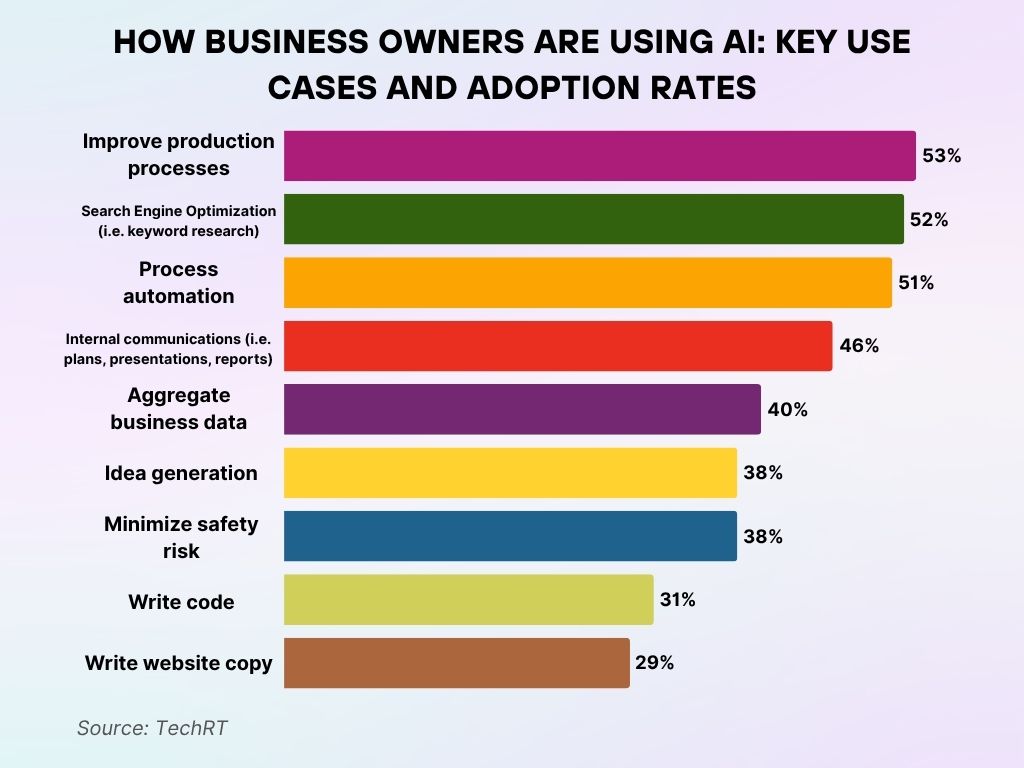
Annual Growth Rate of AI Technologies
- The compound annual growth rate (CAGR) of the AI industry from 2021 to 2025 stands at 37.1%.
- In 2025 alone, AI software revenue is forecasted to grow by 20.4%, reaching approximately $185 billion.
- AI hardware components, especially AI-specific chips, saw a 17% increase in shipment volume compared to 2024.
- The market for edge AI devices grew by 33% year-over-year, as demand surges for privacy-focused local processing.
- The natural language processing (NLP) sector expanded by 24.6% in 2025, driven largely by growth in multilingual and voice AI systems.
- Computer vision technology is now used in 72% of retail AI deployments.
- The AI robotics industry saw global investments hit $23 billion, up from $17.9 billion last year.
- AI-as-a-service platforms (AIaaS) are growing fast, with subscription revenues increasing 40% year-over-year.
- Global spending on AI integration services is projected at $61 billion in 2025.
- AI chipsets optimized for deep learning, such as tensor processing units (TPUs), grew in demand by over 50% from enterprise buyers.
Distribution of AI Use by Sector
- The finance sector accounts for 21% of global AI investment in 2025, making it the top industry for AI funding.
- Healthcare AI now represents 18% of total AI deployments, focused heavily on diagnostics and drug discovery.
- In retail, 64% of e-commerce platforms now use AI for personalized recommendations, up from 48% last year.
- Manufacturing industries reported a 43% AI adoption rate in production automation and predictive maintenance systems.
- Government and public sector AI use has increased to 11%, particularly in smart city and surveillance tech.
- Transportation and logistics now integrate AI in 76% of global shipping companies.
- Education technology companies (EdTech) have reached a 36% AI adoption rate, often through adaptive learning platforms.
- The energy sector’s use of AI for smart grid management climbed to 28%, with particular growth in renewable integration.
- AI use in agriculture has expanded, with 19% of commercial farms now utilizing AI for crop health monitoring and yield predictions.
- Media and entertainment industries have adopted AI in 42% of content production processes, particularly generative tools and deepfake detection.
Top Perceived Benefits of AI
- 43.1% believe AI boosts productivity, making it the most commonly recognized advantage across industries.
- 39.4% highlight AI’s power to enhance decision-making, aiding both strategy and daily operations.
- 35.3% say AI helps reduce error rates, increasing accuracy and task reliability.
- 34.0% value AI for its ability to cut response times, especially in customer service scenarios.
- 30.9% view AI as a tool for streamlining job processes, taking over repetitive or manual tasks.
- 30.8% appreciate how AI improves customer relationships through personalization and faster interactions.
- 25.3% cite cost savings as a key benefit, making AI appealing for budget-conscious operations.
- 19.6% see AI’s potential to increase sales, linking automation to stronger revenue performance.
- 4.1% reported no perceived benefit, signaling skepticism or limited awareness of AI’s value.
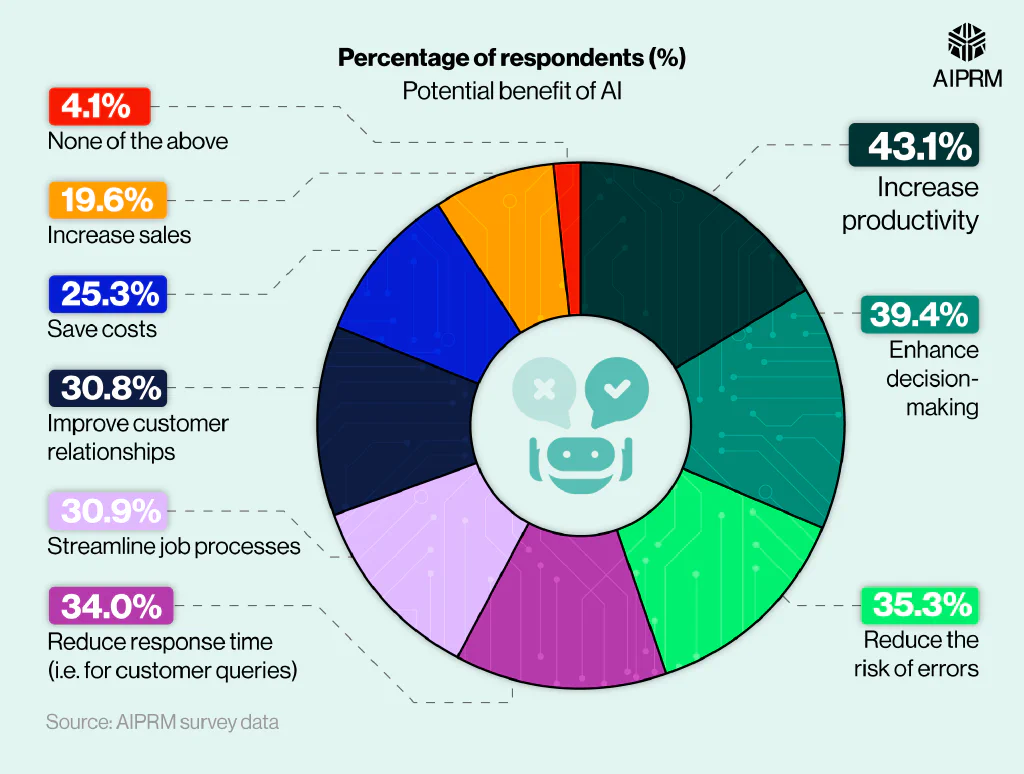
Leading Countries in AI Implementation
- The United States leads global AI implementation, with 84% of large enterprises reporting active AI use in 2025.
- China follows closely, with 79% enterprise AI adoption, especially in finance, logistics, and smart infrastructure.
- South Korea surpassed 55% national AI integration in manufacturing, making it a top-tier automation hub.
- Germany reports 62% AI use in industrial sectors, with a strong focus on autonomous machinery and robotics.
- The UK has achieved 58% adoption in AI-led business decision-making, particularly in the financial and legal sectors.
- India has seen a 44% increase in AI startup activity over the past year, with notable acceleration in AI healthcare apps.
- Canada’s AI talent pool grew by 29%, supporting its rise as a leading AI research and development ecosystem.
- France’s national AI strategy has funneled over €6.5 billion into AI by 2025, doubling its 2021 investment.
- The United Arab Emirates (UAE) continues to invest aggressively, achieving 47% AI integration across public services.
- Singapore leads Asia in AI regulation maturity, rolling out Asia’s first AI governance testing sandbox in 2025.
AI Spending by Corporations and Governments
- In 2025, global corporate AI spending is projected to reach $212 billion.
- Government AI investments worldwide are expected to total $78.4 billion, driven by national security, healthcare, and smart infrastructure initiatives.
- The US federal government’s AI budget allocation for 2025 stands at $12.8 billion.
- Private sector R&D spending on AI has grown by 19.3%, with leading contributors being the finance, automotive, and biotech industries.
- Europe’s Digital Europe Programme has committed €2.5 billion in AI funding for public-private partnerships by 2025.
- Asia-Pacific AI spending rose to $64 billion, led by China, India, Japan, and South Korea.
- AI investment in cloud platforms reached $59 billion, driven by the integration of scalable AI into enterprise cloud environments.
- Over 71% of Fortune 500 companies have dedicated AI budgets in 2025, compared to 58% last year.
- AI in defense accounts for nearly $14 billion globally, with increasing focus on autonomous systems and threat detection.
- Public-sector pilot projects in AI have doubled since 2023, particularly in digital identity, fraud prevention, and service delivery automation.
Smartphone Users: AI Awareness vs. Actual Usage
- 50% of users recognize predictive text, but only 35% actively use it to enhance typing speed.
- 39% are aware of AI-powered route suggestions, while 24% rely on them for better navigation.
- 37% know about voice assistants, yet just 12% use them, showing a gap in trust or adoption.
- 31% are aware of voice search, but usage is low at 9%, signaling untapped potential.
- 25% recognize translation apps, with 11% using them for travel or cross-language communication.
- 25% know about voice-to-text, but only 7% take advantage of it for hands-free messaging.
- 23% are aware of AI email classification, while 12% use it to keep inboxes organized.
- 21% know of automated calendar entries, and 10% utilize them for task planning.
- 20% are familiar with location-based app suggestions, but just 5% use this contextual AI feature.
- 20% also know about photo classification by AI, with 9% using it to sort and manage images.
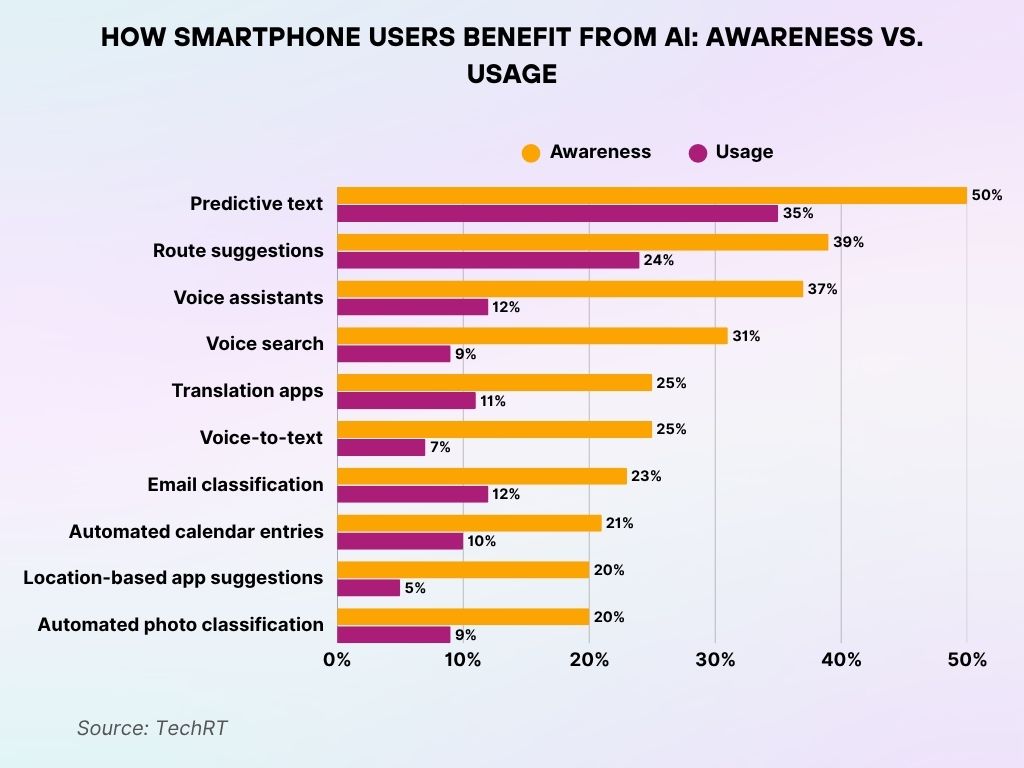
Workforce Transformation Due to AI Integration
- In 2025, AI-driven automation is estimated to affect 330 million jobs globally, but it is also expected to create about 150 million new roles.
- 40% of US organizations report restructuring their workforce to integrate AI tools effectively.
- Upskilling and reskilling budgets grew by 29% across enterprise L&D departments, emphasizing AI literacy.
- Prompt engineering roles have seen a 73% year-over-year increase in job listings since 2024.
- A new category of jobs called “human-in-the-loop AI managers” emerged in 2025, focused on oversight and quality control of AI decisions.
- 82% of HR leaders now report integrating AI in talent acquisition, mostly for resume parsing and bias detection.
- In manufacturing, AI has reduced manual workloads by an average of 31%, prompting workforce redeployment into monitoring and analysis tasks.
- Healthcare support staff are increasingly being replaced by AI chatbots and virtual assistants, covering nearly 60% of initial patient intake.
- Despite concerns, employee satisfaction in AI-augmented roles improved in 58% of surveyed workplaces, thanks to reduced task monotony.
- Labor unions in Europe and North America have introduced AI transparency clauses in 18% of collective bargaining agreements.
AI-Driven Product and Service
- Generative AI tools are now embedded in 47% of new software applications.
- AI-generated content makes up an estimated 32% of all digital marketing materials in 2025.
- Voice-based AI assistants saw a 41% increase in B2C product integrations, especially in smart home and vehicle interfaces.
- AI chatbots handle more than 80% of initial customer service interactions for enterprise websites.
- Financial robo-advisors, powered by AI, manage over $2.4 trillion in assets globally, compared to $1.8 trillion last year.
- Smart recommendation engines, particularly in e-commerce, now drive up to 38% of all product purchases.
- In education, AI tutors are used by more than 110 million students worldwide, offering real-time assistance and feedback.
- Personalized AI health tools, including virtual symptom checkers and wellness tracking apps, are adopted by over 65% of mobile health users.
- LegalTech AI solutions have been implemented in 42% of law firms in the US, helping with case research, contract analysis, and due diligence.
- AI-driven logistics platforms enable real-time route optimization for over 70% of major delivery companies.
Global AI Revenue Forecast by Use Case
- $8,986.57 million projected for machine/vehicular object detection and avoidance, making it the top-grossing use case.
- $7,642.83 million expected from static image recognition and tagging, reflecting strong adoption in visual AI.
- $7,259.35 million forecasted for patient data processing, showing AI’s growing role in healthcare management.
- $6,394.41 million projected in algorithmic trading performance, underlining AI’s financial sector impact.
- $5,950.55 million estimated from localization and mapping, essential for autonomous and navigation systems.
- $5,713.60 million expected from predictive maintenance, helping drive industrial efficiency and uptime.
- $5,385.10 million forecasted for cybersecurity threat prevention, showcasing AI’s role in digital protection.
- $5,370.85 million to come from digital paperwork conversion, streamlining admin workflows with automation.
- $5,295.03 million predicted for AI in recruitment and HR, boosting talent acquisition and management.
- $5,111.31 million expected from medical image analysis, enhancing diagnostics and clinical insights.
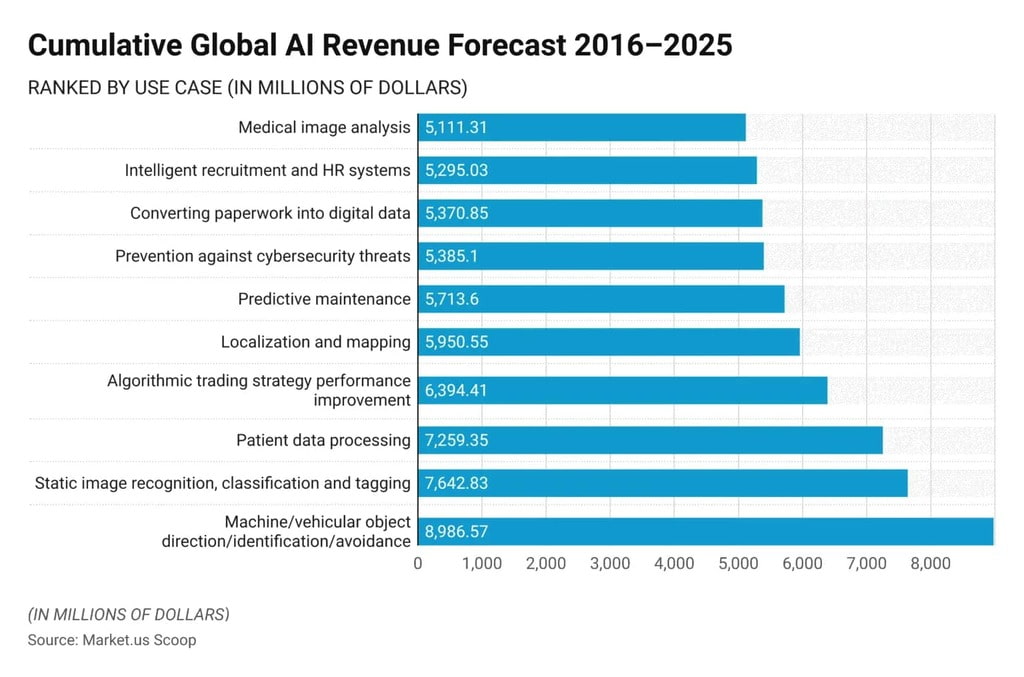
Performance Metrics of AI Systems
- In 2025, the average accuracy rate of advanced language models has improved to 94.2% across standardized benchmark tasks.
- Real-time AI inference speeds are now up to 35% faster than in 2024, primarily due to optimized AI accelerators and edge processing.
- AI system error rates in facial recognition dropped below 0.1%, but disparities remain across ethnic groups.
- Energy efficiency per AI training cycle improved by 28%, helping mitigate carbon concerns associated with large models.
- Open benchmark participation, such as MLPerf, increased by 22%, encouraging transparency in performance claims.
- AI model hallucination rates fell by 19% on average, thanks to improvements in context handling and response grounding.
- In robotics, AI decision latency is now under 12 milliseconds, making autonomous systems more responsive and reliable.
- AI-driven fraud detection systems in financial services boast a 97% detection success rate in 2025.
- Conversational AI satisfaction ratings among users improved to 4.4 out of 5, compared to 3.9 last year.
- Model compression techniques are now used in 58% of production AI deployments, improving speed and reducing memory usage without major accuracy loss.
AI in Healthcare, Finance, and Education
- AI in healthcare is estimated to generate $82.1 billion in global revenue in 2025, driven by diagnostics, imaging, and virtual health solutions.
- 63% of hospitals in the US now use AI-powered clinical decision support tools.
- AI is used in 42% of medical imaging workflows, reducing diagnostic time by up to 37%.
- Telehealth platforms integrated with AI triage assistants handle over 50 million patient sessions monthly worldwide.
- In finance, AI-based fraud detection tools blocked an estimated $38 billion in fraudulent transactions globally in 2025.
- 73% of US banks use AI for real-time credit scoring, loan approvals, and risk modeling.
- Automated investment advisory platforms powered by AI serve more than 89 million users globally.
- AI in education supports personalized learning for over 300 million students, with adaptive platforms tailored to learning styles and pace.
- University adoption of AI grading tools has reached 39% in the US, accelerating feedback cycles and grading consistency.
- AI chatbots for student support are active in 57% of higher education institutions, handling routine queries and enrollment processes.
Global AI Market Size Forecast (2020–2030)
- In 2020, the AI market was valued at $93.27 billion, marking the start of a decade of explosive growth.
- By 2021, it more than doubled to $202.59 billion, reflecting rapid enterprise adoption.
- In 2022, it settled at $124.79 billion, signaling a post-pandemic market adjustment.
- 2023 saw renewed growth, reaching $135.93 billion, driven by generative AI momentum.
- 2024 is projected to end at $184.04 billion, fueled by AI integration and automation trends.
- The market is expected to hit $243.72 billion in 2025, supported by machine learning advancements.
- 2026 forecasts show $320.14 billion, thanks to strong investment in AI infrastructure and R&D.
- By 2027, the market could rise to $415.61 billion, as AI becomes core to industries like healthcare and finance.
- In 2028, size may surpass $529.23 billion, indicating mainstream enterprise adoption.
- 2029 projections reach $667.74 billion, backed by government support and global AI strategies.
- By 2030, the market is expected to soar to $826.73 billion, representing nearly 9x growth from 2020.
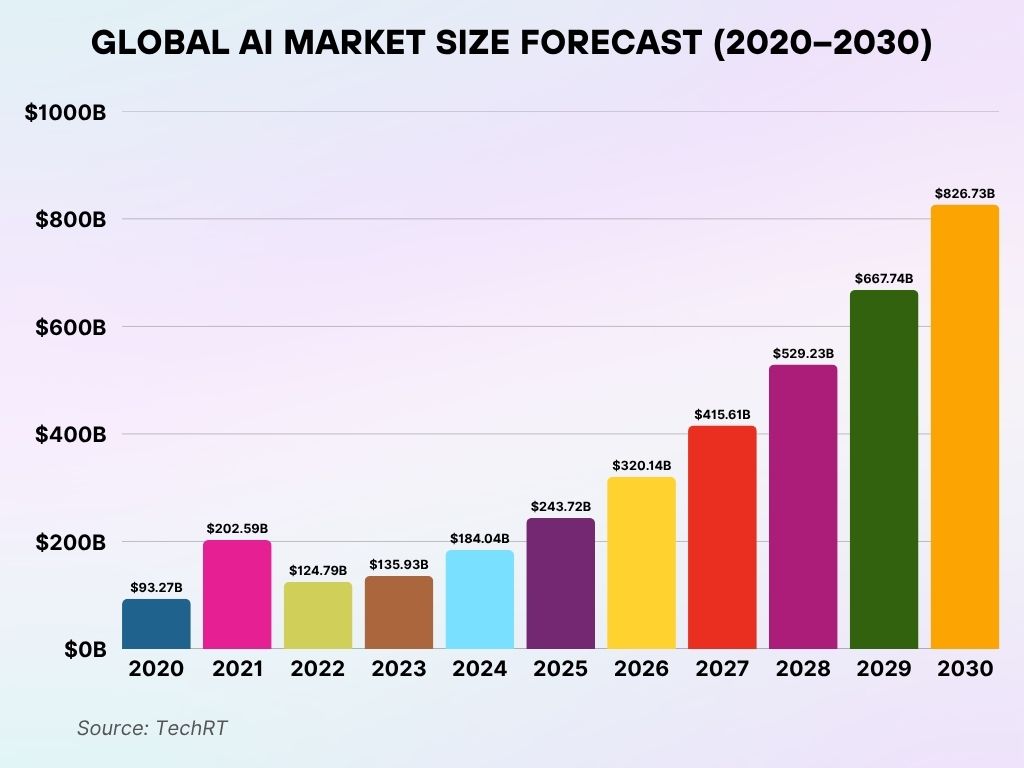
Open-Source vs. Proprietary AI Development
- In 2025, 42% of AI models in production will be open-source-based.
- Proprietary models still dominate enterprise use, making up 58% of AI deployments, especially in finance, law, and biotech.
- The most popular open-source AI foundation model in 2025 is adopted by over 6,500 companies worldwide.
- Meta and Hugging Face led the open-source AI model releases in 2025, with several models matching or outperforming proprietary alternatives.
- Open-source AI repositories on GitHub crossed 1.3 million public projects, marking a 22% growth year-over-year.
- Enterprise-grade open-source AI tools have increased in adoption by 31%, often enhanced with internal proprietary tuning layers.
- Security and compliance concerns remain the biggest barrier to open-source AI adoption in regulated industries.
- Hybrid models, combining open-source base models with proprietary fine-tuning, account for 26% of deployments.
- AI governance frameworks increasingly emphasize transparency, favoring open-source visibility.
- Developers report 34% faster time-to-deployment when using open-source AI stacks, due to pre-trained weights and community support.
Cybersecurity and AI Risk Statistics
- AI-driven cybersecurity tools block over 1 billion cyber threats daily as of early 2025.
- Ransomware detection accuracy has improved to 96.7% with real-time AI monitoring systems.
- 48% of enterprises now deploy AI for phishing detection and response automation.
- AI-powered intrusion detection systems have reduced mean time to detect (MTTD) by over 43% year-over-year.
- Synthetic identity fraud is increasingly flagged by AI algorithms, protecting $21 billion in assets in 2025.
- AI-generated cyberattacks (e.g., polymorphic malware) represent a growing threat, prompting 36% of firms to upgrade their AI-based defenses.
- Over 600 cybersecurity startups worldwide will integrate AI at their core offering in 2025.
- AI security training data poisoning attacks increased by 17%, emphasizing the need for robust model validation.
- Zero trust frameworks incorporating AI are used in 54% of major cloud environments for anomaly detection.
- The White House Cybersecurity Strategy 2025 explicitly mandates AI safety audits for all federal AI applications.
AI Revenue Forecast by Use Case (2016–2025)
- $8,097.9 million expected from static image recognition and tagging, making it the top-earning AI use case.
- $7,540.5 million projected for algorithmic trading improvements, highlighting AI’s deep impact in finance.
- $7,366.4 million anticipated from patient data processing, emphasizing AI’s role in healthcare scalability.
- $4,680.3 million forecasted for predictive maintenance, helping reduce machine downtime and improve efficiency.
- $4,201.0 million expected from geospatial object detection, supporting mapping and satellite-based analysis.
- $3,714.1 million projected for text-based image queries, boosting image search capabilities.
- $3,655.5 million estimated from automated geophysical feature detection, aiding exploration and scientific research.
- $3,566.6 million forecasted for AI-driven content distribution on social media, enabling personalized marketing.
- $3,169.8 million expected for object detection/navigation, key in autonomous systems and robotics.
- $2,472.6 million projected for cybersecurity threat prevention, showing continued reliance on AI for digital safety.
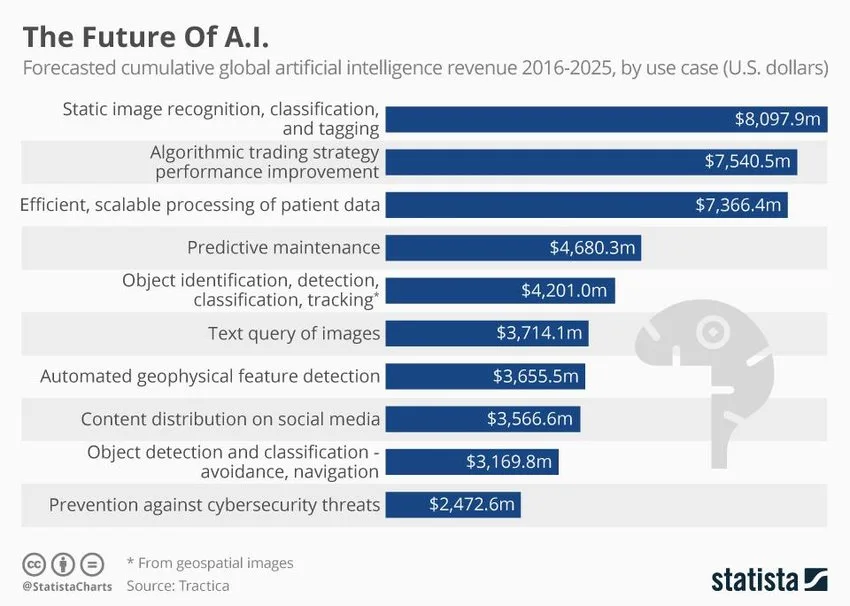
Environmental Impact of AI Technologies
- AI model training emissions for large language models (LLMs) average 88 metric tons of CO₂ per model, prompting widespread concern.
- 58% of AI development firms now report on energy usage.
- AI compute efficiency has improved by over 30% through innovations in sparsity and quantization techniques.
- Data center optimization with AI has reduced total cooling energy needs by 15% on average in 2025.
- Green AI models (optimized for energy use) are being adopted in 29% of production systems.
- Carbon-offset commitments are reported by 21 of the top 30 AI companies, totaling over 2.3 million tons offset.
- Federated learning and edge AI are being used to reduce centralized compute loads in 36% of new mobile AI applications.
- AI-assisted energy management systems are being deployed in 22% of smart cities, cutting down peak grid loads by 9%.
- Hardware recycling programs linked to AI chip makers are expanding, with 45% growth in 2025 participation.
- Sustainable AI research papers have increased by 64%, highlighting academic and industry alignment toward greener innovation.
Recent Developments in Artificial Intelligence
- GPT-5 and other next-generation models released in 2025 offer over 1 trillion parameters, pushing capabilities in multimodal reasoning.
- Multimodal AI platforms (text, image, video) now serve 41% of enterprise use cases, from training to content generation.
- AI regulation bills have been passed in over 23 countries, aiming to enforce ethical boundaries, transparency, and risk management.
- Synthetic data generation tools are used by nearly 40% of AI teams, reducing dependency on real-world data and enhancing privacy.
- AI-human collaboration interfaces have gained momentum, with augmented reality AI tools becoming standard in design and fieldwork.
- “AI agents” with autonomy and memory have started to replace task-based assistants in enterprise workflows, performing ongoing multi-step actions.
- Neurosymbolic AI systems are making headway, combining symbolic logic with neural networks for explainable decision-making.
- Specialized domain AI models (e.g., legal, chemistry, materials science) are growing rapidly, often outperforming general-purpose models in task accuracy.
- AI in creative work is now used by 76% of professional graphic designers, 62% of video editors, and 59% of writers.
- The global AI talent pool has grown to over 4.7 million professionals, with emerging hotspots in Latin America and Southeast Asia.
Conclusion
Artificial intelligence in 2025 has matured into a mainstream, high-impact technology shaping global economics, workforce dynamics, innovation, and governance. Its rapid advancement is paired with growing attention to ethics, environmental sustainability, and responsible deployment. From healthcare diagnostics to smart logistics and AI agents handling creative workflows, AI is no longer a tool, it’s a collaborator.
Yet challenges remain. As we move forward, clarity around regulations, transparency in model development, and equitable access to AI resources will be key to ensuring that AI works for everyone, not just the few.


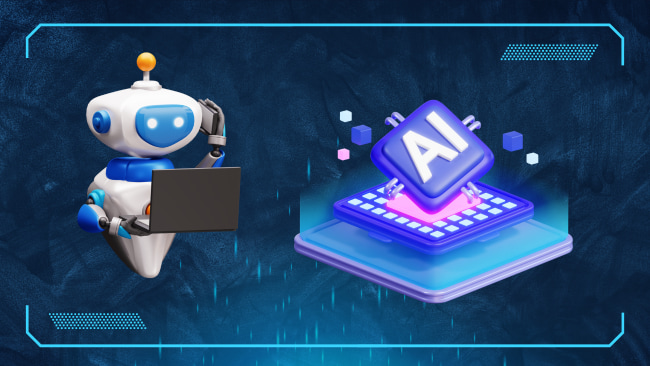
Leave a comment
Have something to say about this article? Add your comment and start the discussion.